Parcel and freight shipping services are two terms in the transportation industry that are used interchangeably. Many shippers don’t realize how drastically different they are from one another. If you want to enjoy a successful shipping experience, it’s essential that you’re able to tell the difference between the two.
Key takeaways:
We’ll break down the differences between the two to help you determine which service is best for you.
A parcel is typically a small package or envelope that’s shipped using postal or courier services. Parcels are shipped and delivered separately, rather than being palletized into one load. Most parcel shipments go through multiple checkpoints and transfers before arriving at the final destination.
You should use parcel shipping when:
In today’s world, customers want their goods as soon as possible. If time isn’t on your side, parcel shipping allows for 2-day, overnight, and even same-day delivery options.
Parcel transport is ideal for small and lightweight orders. This is perfect for e-commerce & small businesses that need to send one-off shipments to customers all over the country. Parcel shipments can vary in size, but here are the typical measurement and weight limits.

Due to the frequency of parcel shipping, many of the carriers that perform the service are able to offer affordable prices. The small size and lightweight nature of parcel shipments help with their affordability as well.
When you ship a parcel, you and your customers will be able to track it accurately from start to finish. This gives both parties full visibility of the package or envelope.
Freight refers to large shipments of cargo that are transported in via truck, rail, vessel, and aircraft. Freight is often secured to a pallet, but it can also be transported as loose packages. While freight shipments can stop at different terminals along a route, they travel a more direct path to the final destination than parcels.
You should use freight shipping when:
Freight shipping is the best method to use when you need to ship large volumes of cargo at once. To demonstrate this, consider how many boxes you’re able to secure to a 48” x 40” pallet.
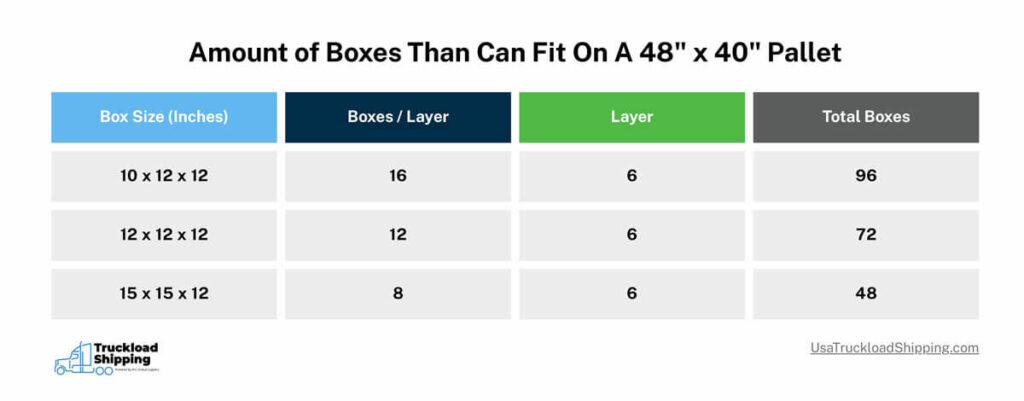
Freight shipping allows you to take advantage of multiple transportation modes and services. For loads that are time-sensitive, you can take advantage of air transport. Vessel transport is essential if you’re shipping goods overseas.
As far as truckload services are concerned, you can take advantage of LTL or FTL. LTL shipments are usually eight pallets or fewer, and they share trailer space with other people’s freight.
FTL shipments dedicate an entire trailer to one shipper, regardless of shipment sizer. These two options give you the flexibility to pick a transportation solution that’s best for your cargo.
Finally, freight shipping is best for long-haul transport. The pricing models for freight shipping are designed to benefit high volume shipments that are traveling long distances. Using multiple modes of transport, which are often necessary for long-haul shipments, also help with cost-effectiveness.
The cost of parcel and freight shipping can vary drastically based on the cargo, distance, mode of transport, and much more. For the sake of simplicity, we’ll focus on the cost structure
of parcel and freight shipments transported by truck in the following sections.
A parcel shipment typically costs between $4.50 and $20. The parameters carriers use in the parcel cost structures can vary.
That said, here are the most common factors they consider:
The actual weight is the parcel’s mass after being measured on a scale, while dimensional weight accounts for the volume of the parcel. Whichever weight is higher is the one carriers apply in their calculation.
Distance plays an important role as well. The farther a parcel travels, the more a customer will have to pay.
The specific shipping service is the final factor. Faster modes of transport, like 2-day or overnight shipping, are more expensive because they require more effort on behalf of the carrier.
The cost structure for freight shipping differs between FTL and LTL. Let’s take a look at the FTL cost structure first.
All of these factors are evaluated to provide FTL shipments with a per-mile or flat rate. Dry van rates for FTL are between $1.50 and $2.20, but they change every week.
The cost structure for LTL shipments are based on the freight class and NMFC code of the cargo. Freight class is used to categorize freight into one of 18 classes, while NMFC codes are specific identifiers that are assigned to each commodity.
While you’ll pay less for LTL than FTL, giving an accurate estimate is difficult due to the complexity of freight classes and NMFC codes.
Parcel and freight shipments can take anywhere between one and seven days before reaching the final destination. Shipping times are largely determined based on distance and the service used.
While transit times are similar for both services, it should be noted that it takes exceptionally more time to prepare a load of freight. Cargo must be gathered and secured to a pallet. Carriers will also require you to set up a pick-up date. However, a carrier’s schedule can severely restrict the pick-up date you select.
Parcel shipments are much easier to prepare. You simply pack your box or envelope and take it to your courier of choice for shipping.
Here at USA Truckload Shipping, we’ve been transporting freight for decades. Our extensive carrier network allows us to find the right transportation solution for our customers and their freight. When you choose USA Truckload Shipping, you’ll be able to enjoy a variety of transportation services.
If you’re looking for a long-term transportation provider, USA Truckload Shipping is ready to be your partner. Enjoy the services we provide by filling out your Request for Proposal (RFP). If you have any questions about our services, call us at (866) 353-7178 or reach out on our contact page.
PTL and FTL are two methods of transporting freight that shippers often get confused. Each one offers unique advantages that can be useful in certain scenarios. That said, you might be unsure which service is right for your shipment. Let’s take a look at how PTL and FTL differ from one another.
Key takeaways:
We’re going to cover the finer details of these points to help you better understand how these services are used.
The difference between PTL and FTL comes down to three basic factors:
PTL shipments are smaller than FTL, but larger than LTL. Trailer space for is shared between two or more shippers. That said, PTL freight experiences fewer stops than LTL shipments because fewer people share trailer space.
FTL shipments are arranged so that only one shipper’s goods occupy the space of a trailer. Ideally, the shipment fills the entire trailer, but not always Once FTL cargo is loaded, it doesn’t stop until it reaches the final destination.
Here’s some data we’ve provided that shows the average difference in size between PTL and FTL shipments.
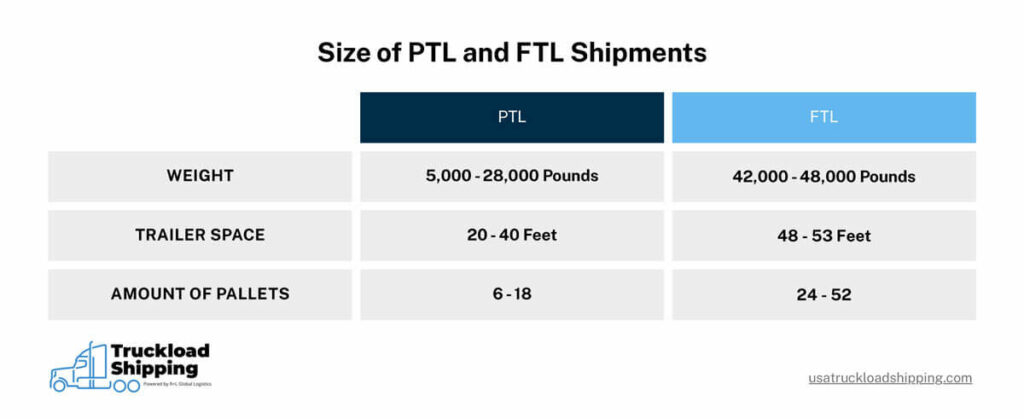
Your shipping needs will vary based on your unique situation. We’ll discuss the best scenarios to use each service in the following sections.
PTL is used less often than other methods of ground shipping. That said, there are a variety of situations where it can be helpful.
Since PTL is less common, you may have a harder time finding a transportation provider. Here at USA Truckload, we offer a variety of solutions to help you overcome logistical challenges.
FTL shipping is frequently used by shippers all across the country because of its many practical applications.
One downside about FTL is that it’s not an adaptable method of moving freight. Therefore, you won’t be able to make changes to your load, such as adding or removing items, once it’s been shipped.
FTL shipping rates can cost anywhere between $1.50 and $3.50 per mile. Distance is the leading factor that determines the cost of FTL rates. However, there are other factors at play.
FTL rates change week-by-week, and in some cases, day-by-day. Make sure to check current rates prior to booking a load. This will help you accurately estimate how much your shipping expenses will cost.
Factors that influence PTL shipping costs include:
The amount of space your freight takes up inside a trailer and how much it weighs have a huge impact on your PTL costs. Heavier and larger shipments are more expensive, while smaller and lighter loads are cheaper.
Packaging can impact space utilization within a trailer. If your freight is palletized, it will utilize space more efficiently and lead to a favorable rate. Bulkier loads, on the other hand, can drive up your costs.
Lastly, the handling requirements for your freight can impact PTL shipments as well. Freight that’s fragile or requires temperature treatment will be more expensive to ship with PTL compared to standard dry goods.
We’ve mentioned LTL shipping a few times, but what exactly is it? LTL, referring to less-than-truckload services, is used for shipments that are too small for FTL and PTL. It’s designed to combine multiple shipments, from different shippers, into one trailer.
The pricing structure is very specific. LTL costs are determined by freight class and NFMC codes, which can be a complex way of calculating transportation expenses for new shippers.
While the trailer sharing structure is similar to PTL, the number of shippers per trailer is usually higher. This also means transit times will be longer because multiple stops have to be made for the loading and unloading of each shipment. As a result, cargo damage is more likely to occur.
A PTL shipment does share trailer space, but with a limited number of other shippers. Depending on the carrier providing the services, pricing structures can also vary greatly. Some may still classify the goods as they would for LTL, while others focus on space and distance only.
Whether you need to ship LTL or FTL (or something in between), USA Truckload Shipping has you covered. Our vast network of small carriers can move your freight with care and speed anywhere in the United States.
Have a special request to make? With our premium carriers, we’re able to provide an assortment of transportation options.
If you’re ready to begin a long-term relationship with a reliable 3PL, then fill out your RFP today. For any inquiries about the services we offer, reach out to one of our team members at (866) 353-7178. You can also contact us through our site.
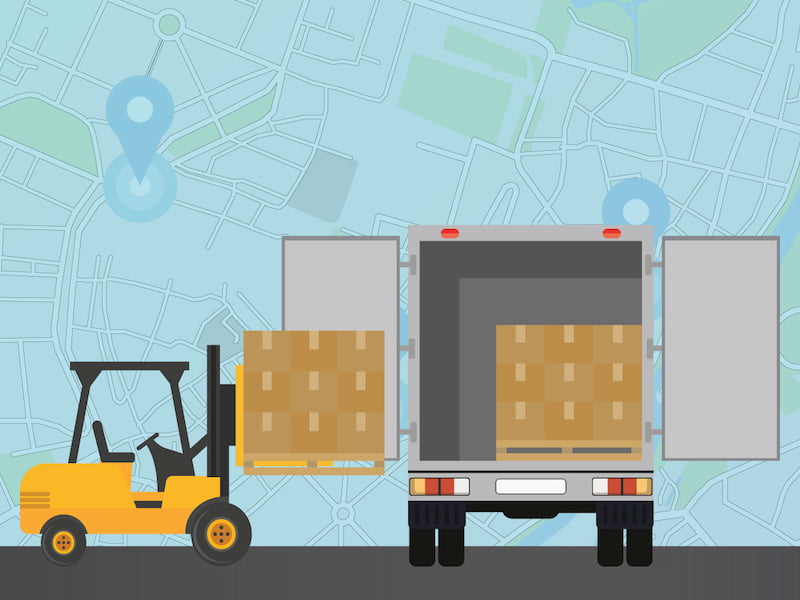
This is a common question we’re asked so frequently that today we’re bringing you up to speed.
Find out what LTL means in shipping, how it relates to partial truckloads, when to use an LTL carrier vs a full truckload option, and more.
Get on the road to understanding the ins and outs of LTL trucking.
Less-than-truckload shipping refers to cargo delivered to multiple places from the same trailer. Typically, the freight on board is from two or more shippers.
An LTL carrier will accept hauls from multiple shippers and deliver to various locations with the goal of filling a trailer as much as possible. That doesn’t mean the truck will never have empty space, just that it depends on the loads each time.
As a business owner or logistics manager, it’s important to know that LTL trucking is available and can help with growth and profitability too. The top industries using LTL include:
You might even be familiar with some businesses that use LTL shipping such as: Birchbox, JuicePlus+, and Stitch Fix.
A full truckload (FTL) haul means there is one shipper and one destination. This is vastly different from LTL, which as outlined above, services multiple shippers and multiple destinations all in one trailer. To learn more about how LTL and FTL differ, check out our blog on FTL vs LTL Freight.
Determining the best freight shipping service for your business needs is important on many levels. For instance, you don’t want to overpay, cutting into profits, nor do you want to end up with a poor reputation because items were damaged, late, or worse…missing. Here’s a list of things to consider to make sure LTL shipping is the right choice:
For example, you’re an artisan woodworker running a mid-sized manufacturing business of custom furniture who’s established contracts with five boutique home décor stores across the Southeast. Let’s say each store requires a bi-weekly restock delivery. Each consists of a mixed load of furniture pieces, averaging 6–8 pallets per shipment, weighing roughly 4,000–6,000 lbs total.
Using FTL shipping for each destination means that you’d have to pay for the full capacity of a truck (typically up to 26 pallets or 44,000 lbs), even though you don’t need that much space. That’s an inefficient and costly option under these circumstances, especially with deliveries spread across multiple cities.
LTL can speed up that process by having deliveries go out at the same time on multiple trucks and still save the business money.
Even though LTL shipping is all about sharing the truckload with other shippers, there are still other benefits we haven’t yet discussed. Grab a coffee (or tea) and we’ll hit these quickly.
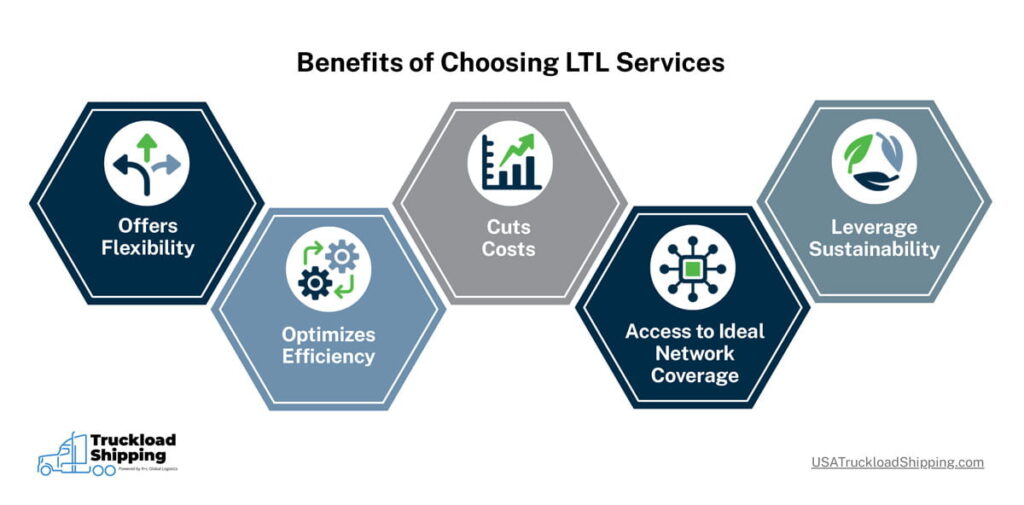
Carriers in the LTL space offer a range of services such as inside pickup and delivery, expedited shipping, possibly even liftgates, each of which helps cater to various needs.
These consolidated LTL shipments help optimize the use of each truck, the transportation resource. And with fewer trucks on the road, there’s less traffic congestion too.
Who doesn’t want to reduce their shipping costs? As a cost-effective solution, LTL trucking is usually more affordable than FTL for limited pallet loads because of its main premise: shared transportation.
Most top-tier LTL carriers have access to national and regional carrier networks. Why is this important? It puts you in the driver’s seat of your business growth by expanding your shipping options over a wider geographical area. When you need to expand into a new region, there won’t be a need to hunt for new carriers.
With LTL shipments, the consolidation of cargo minimizes the number of trucks on the road. This leads to reducing emissions and fuel consumption, which gives you an opportunity over your competition. How? Incorporate your eco-friendly business practices into your marketing.
There are a handful of reasons LTL shipping is a fool-proof choice for US businesses above and beyond the benefits already outlined above. For example, because you’ll be shipping smaller quantities more frequently, you don’t need to delay shipping waiting to clear a full truckload.
You also won’t need to rely on a large warehouse to store your products either (which increases your expenses and decreases your bottom line). Moreover, you can keep inventory flowing which is another way to reduce your inventory cost.
In short, LTL trucking can help streamline your operations and minimize overhead. It will also help you avoid overstocking and understocking issues.
Now you know what LTL shipping is and when it’s ideal to use. You’ve familiarized yourself with some of the industries that include LTL shippers and the benefits these businesses enjoy from such a freight service.
Who do you turn to for this logistics need and high-level expertise? USA Truckload Shipping has an unparalleled LTL network across the US that you can leverage.
Our full list of services includes:
Call us at (866) 353-7178 or submit a contact form online. Get in touch today, so your shipment can be on the road tomorrow.
Shipping furniture is full of challenges. It can be costly, and there’s always the chance your freight could be damaged while in transit. This can make finding the right solution for your cargo is extremely difficult. Fortunately, LTL shipping is a great solution that can address these concerns. Here’s what you need to know.
Key takeaways:
Let’s take a closer look at these points to better understand how LTL will help you ship furniture.
Furniture, whether prebuilt or flat-packed, is often heavy and awkward to ship. That combination also makes the process very expensive. Depending on your business model, shipping a full truckload may be impractical physically and financially, especially if you need to distribute to more than one location.
LTL, or less-than-truckload, is a more cost-effective way of transporting high value freight to multiple locations or when multiple stops are needed. With this mode of shipping, your furniture will be mixed in with other shipments. This means you won’t be paying for the space of an entire trailer.
Like other methods of shipping, you can add on other LTL services to your shipment. LTL also provides flexibility in terms of the size of your shipments and frequency you require transportation services.
Related: Difference Between FTL and LTL
Using LTL to move your furniture is pretty straightforward. We’ll show you how to set up your shipment in the following sections.
Packing your furniture for LTL shipping requires the completion of multiple steps. Some steps will depend on how far a piece can be broken down or whether it’s shipped in a box as a flat pack item. For instance, certain couches and tables must be shipped as whole pieces.
First, detachable parts on your furniture should be removed prior to shipping. This might make them easier to palletize later on, as well as prevent damage to more delicate pieces.
Parts that should be removed or separated include:
You should wrap all detachable parts carefully to give them adequate protection. Don’t try to forcibly remove these pieces if they’re supposed to stay on the furniture. The hardware needed to reassemble the detachable parts, like screws, bolts, and other small pieces, should be labeled and bagged.
Certain parts of your furniture, like the corners, may require additional protection. You can provide this by putting small strips of cardboard on these sections of the furniture.
The use of a clear plastic cover over the furniture serves as a layer of protection from debris and possible surface damage. Alternatively, you can use blanket wraps instead of plastic film.
When possible, boxing furniture serves as another layer of protection. Furniture can come in all shapes and sizes, so take measurements carefully to find a suitable box. Once the furniture is inside, you’ll need to fill in any empty space with extra cushioning.
You should also label your furniture appropriately. Doing so notifies workers that your freight should be handled with care and ensure items are delivered to the correct locations.
The final step is to palletize your furniture. With boxed furniture, it’s a simple process. Protecting larger, or more awkwardly shaped pieces, may require the use of custom pallets. The goal is to make it easier for workers to load and unload it from the trailer. The floor of a trailer can also be covered in dirt and even spilled liquids. A pallet will keep your freight slightly elevated off the floor.
All LTL freight shipments must be accompanied by a corresponding freight class and NMFC code. Both are used to calculate the costs of your LTL furniture shipment. Here’s how each one works.
There are 18 total freight classes, but I’ve provided the ones that will most likely apply to your LTL shipment of furniture.
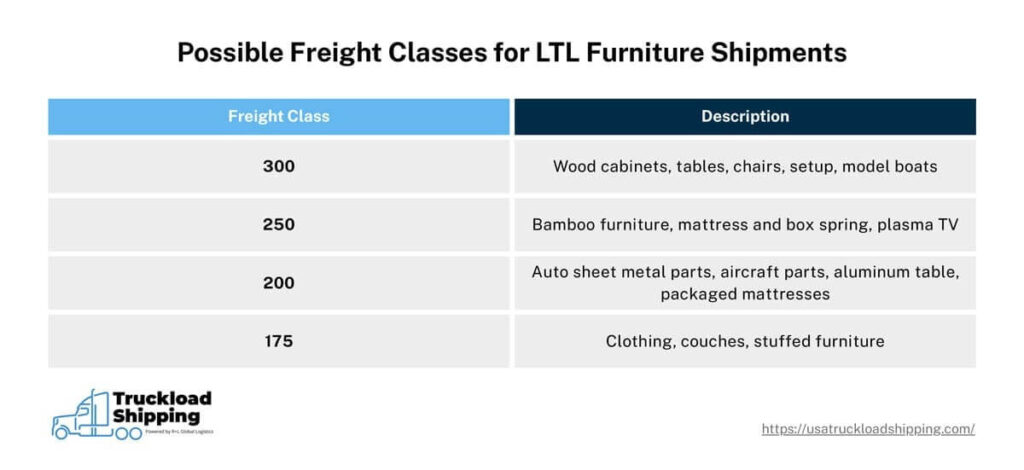
There are nearly 18,000 different NMFC codes. Since there’s so many to choose, we’ve narrowed the list down to the codes that are most commonly applied to LTL shipments.
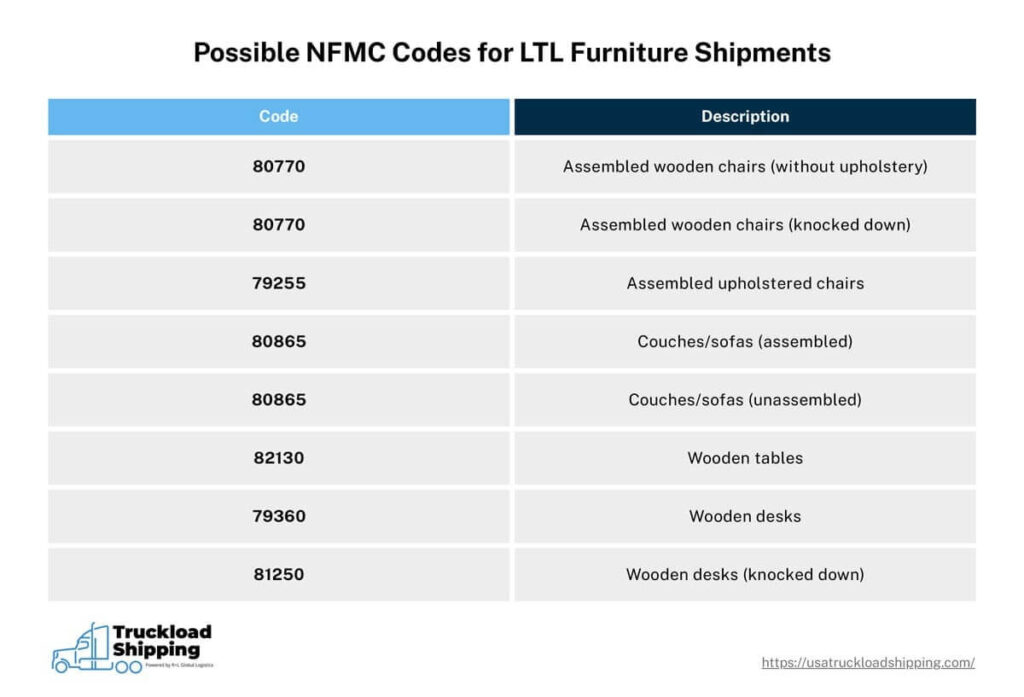
The reality is that shippers rarely select their own correct freight class and NMFC code. Although there are ways to estimate the freight class, the code assigned to your shipments will be determined by the LTL carrier using a system put in place by the National Motor Freight Traffic Association (NMFTA).
Struggling to find the freight class or NMFC code for your furniture shipment? Meet with one of our shipping specialists to determine which ones apply to your furniture during a consulting session.
Shipping documents are essential for LTL furniture shipments. We’ve listed the paperwork you’ll need to provide:
Your BoL, fright bill, and packing list must provide detailed information about the furniture you’re shipping. This includes the freight class and NMFC code. Incorrect information about your furniture could result in complications for your shipment, such as delays and surprise charges.
Make sure to double-check your shipping documents to ensure everything is correct.
Now that your freight is packed, and you have your documentation, you can move on to booking your shipment. This will involve filling out a quote request with your chosen transportation provider.
Among the details you’ll need to provide are:
Once you’ve accepted the price quoted for your furniture, you’ll only need to gather your documents and make your freight available for pickup at the specified date and time. It’s at this stage that your freight class and NMFC code get finalized.
Once you have an established relationship with a carrier or broker, you’ll likely be assigned to a client specialist or executive. This will make arranging loads easier and can pave the way for long-term contracts if you need routine services.
Here at USA Truckload Shipping, we work with a variety of carriers that specialize in furniture transportation and provide you with long term solutions.
While LTL shipping is beneficial for furniture shipping for many reasons, it can fall short when it comes to transit times. LTL freight shares trailer space with cargo belonging to other customers. That means the truck delivering your furniture must stop at multiple locations before reaching the final destination of your shipment.
This can stretch out transit times considerably. We’ve provided some estimated transit times for LTL furniture shipments.
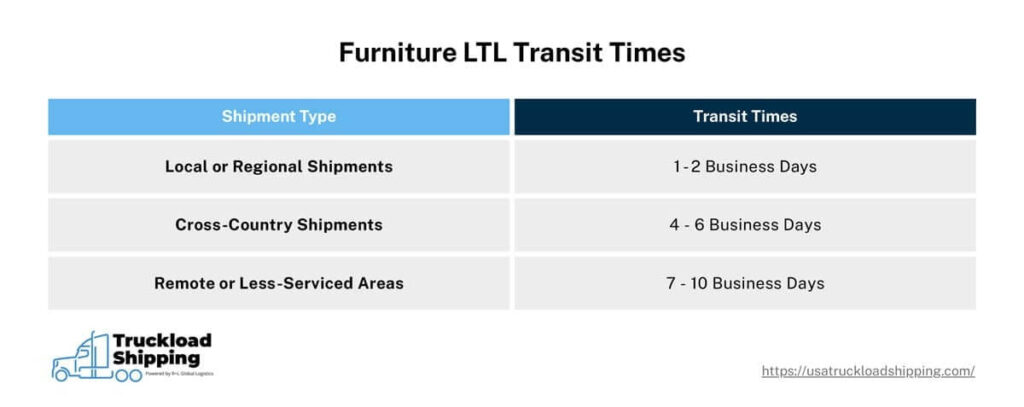
Of course, this can work out to your benefit as well. If you need to restock or fulfill store orders from a central hub, using LTL shipments can actually reduce transit times.
Suppose you maintain the inventory in a warehouse located in western Massachusetts. From there, you use LTL services to restock brick and mortar stores in main cities through the New England Area. Unique orders at multiple stores can be fulfilled at almost the same time because you aren’t waiting to fill an entire truckload and then send that truck out to complete deliveries one at a time.
In either case, keep these transit times in mind so you can provide your customers with realistic expectations regarding the arrival time of their furniture.
The large dimensions of furniture can make it difficult to deliver. Fortunately, there are some additional services that you can use to make this process easier.
Use of these services may depend on whether you are shipping directly to the end consumer (B2C) or to another business (B2B). Distributing to a business is less likely to require these services, as their own employees may be available to handle such matters.
White glove delivery is a service that brings freight into the home of a customer. It’s frequently used when shipping furniture, appliances, or other high value household items. The company performing the service will unpack and assemble the delivered furniture.
Afterward, they’ll place it in an area of specified by the customer. Using white glove delivery will add between $100 and $300 to your LTL furniture shipment. That said, it can be well worth it, as your customer is likely to be impressed by your willingness to provide this service for their convenience.
If your furniture is being delivered to a location where dock loading or unloading can’t be performed, you’ll need to add liftgate services to your shipment. A liftgate is a movable platform on the back of a trailer or truck.
The driver will lower it onto the ground, move your furniture onto it with a pallet jack, and raise liftgate back up. If the liftgate is needed at the final destination, they’ll perform the same procedure in reverse.
Using this service typically costs between $50 and $150, but can sometimes be as high as $540. Despite the increase, it’s a service that’s absolutely necessary when you don’t have a loading dock.
This is more common in a B2C environment, but might also apply to small businesses that lack docking facilities.
Here at USA Truckload Shipping, we can provide LTL transport for your furniture and other personal belongings. We use a network of reliable small carriers that will handle your shipments with care. Our network also has enough capacity to pick up and transport your furniture anywhere in the United States. Here’s a quick look at the services we can offer.
If you’re ready to ship your furniture with LTL, then fill out your USA Truckload Request for Proposal (RFP). Once you’ve completed this document, you’ll have long-term access to our transportation services. For more information about the services we provide, call our team at (866) 353-7178 or reach out to us on our contact page.
Shipping a large item, or several boxed items, can benefit from being secured to a pallet. These simple structures keep your goods off the floor and make loading for pickup and delivery hassle-free. In reviewing the cost of pallet shipping, you’ll see it can also be very economical.
Key Takeaways:
Today, I’ll go over the basics of pallet shipping and what factors will impact how much this service will cost.
Pallet shipping is when goods are secured to a narrow wood or plastic platform, known commonly as a pallet, before being loaded onto a vehicle for transport. A single large item or several boxed items can be prepped and shipped this way.
Used by various businesses and personal shippers, it provides a means to keep cargo secure during the length of its journey. Pallets are designed to be moved via forklift or pallet jack, making loading and loading much simpler and safer, especially when goods need to transfer between transport modes or storage.
Businesses of all sizes rely on standard pallets to ship bulky items, fulfill B2B orders, and otherwise move goods that are too big or heavy for standard parcel post.
Pallet shipping is also an option for individuals who need to move large personal items in a safe and secure environment, either domestically or internationally.
There is no single flat rate charged by carriers to ship a pallet. Multiple factors, ranging from weight to handling needs, will impact the price you’re quoted.
All shipping companies that offer pallet services are going to request additional details about the load to confirm that what you need is within their ability to provide. It also ensures you receive an accurate price estimate.
Before going into those details, I’ll outline some basic price ranges based on per mile estimates.
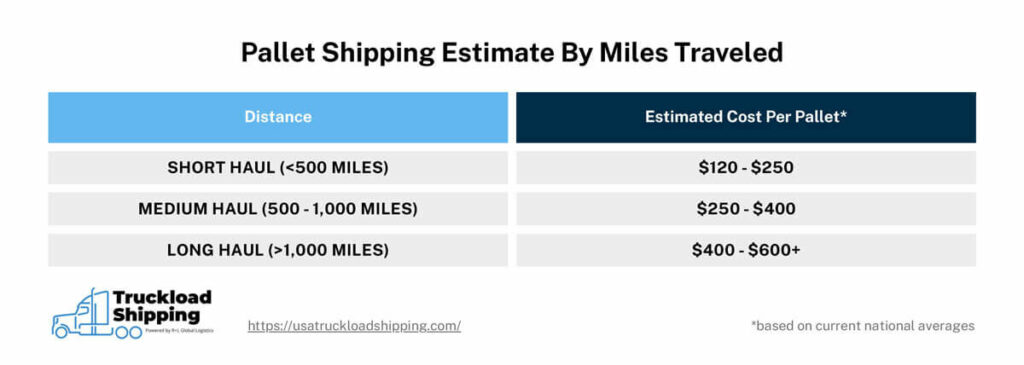
Broken down a bit further, you’re looking at about $1.50 to $3.00 per mile. If you wanted to calculate your shipment in terms of weight, estimate about $0.20 to $0.80 per pound. Your shipping quote should be close to a combined average of these calculations.
Just what factors do shipping companies want more details on? Let’s break it down.
The most common pallet size is a 48” x 40” platform with an average weight capacity of 2,000 pounds. There are other sizes and styles that are larger and/or capable of handling more weight.
For additional protection, you also have the option of shipping your goods in solid wooden crates. Like pallets, they are designed to be easily moved with a forklift or pallet jack.
Goods that are well secured, balanced, and have no overhanging material are ideal. Items on the pallet should also be stacked at a reasonable height. Most carriers will impose a limit between 48 and 60 inches to ensure stability and minimize tipping risk.
Anything exceeding these standard dimensions is more likely to impact the quoted price.
Where and how far your pallet travels to is another detail affecting price. Rates change depending on which region of the U.S. your goods are shipping within or to. This is due to factors such as:
In terms of distance, the farther something must travel, the more it will cost. Carriers have to account for things like fuel consumption, driver compensation, and possibly the need to switch vehicles or transport modes.
For instance, if you are shipping from a rural to an urban area, your pallet may start its journey in a standard semi truck and trailer. However, that same vehicle may not be able to navigate within an urban area due to varying restrictions. In such a case, the carrier moving your load may have to transfer it to a smaller van or box truck for final delivery.
Pallet shipments that require some form of special handling or that carry certain labels will be quoted at higher prices. This can include items that are:
Each of these labels means that the carrier is dealing with added liability. Fragile and perishable items are more prone to damage. Hazardous materials can require the driver to carry additional documentation or even have a special license.
High-risk goods might mean that shipments are at greater chance of theft. This can happen with valuable goods, like jewelry or certain electronics. However, it can also mean goods that can be easily resold and lack tracking, like small electronic accessories or cosmetics.
Related: High Value Cargo Transportation: Lowering Shipping Risks
Making a special request of a driver or carrier company, even if you think of it as a small request, is still likely to impact the price if it’s outside normal activities.
In the shipping industry, these are known as accessorial charges. The availability of these services is more likely to vary from carrier to carrier, so examine the list here carefully.
Other demands, such as signature upon delivery, further limit the window of opportunity for drivers and receivers. Such a request can also increase the chance of failed delivery if someone isn’t available to sign.
Parcel services, or parcel post, generally refer to shipments of single boxes. Companies providing these services, including the U.S. Postal Service (USPS), will charge by box size or weight. However, they typically don’t accept a package that weighs more or is larger than what one individual is expected to carry, even with some assistance.
For the USPS, the limit is 70 pounds. Private companies will accept parcels up to 150 pounds, but dimensions vary since a large package doesn’t mean something is heavy.
Once a shipment exceeds the weight limit set by the carrier, it’s classified as freight and the pricing structure can change.
Pallet services are provided by companies that move freight items and mostly fulfill orders for businesses. Pricing is different (and more expensive) because you are paying for space on a truck, which carriers aim to fill as completely as possible. As mentioned, there are also additional equipment needs that need to be covered.
Most businesses don’t ship enough goods to justify the cost of using an entire standard sized trailer. Carriers are well aware of this, which is why trailer sharing services exist for pallet shipping. Meanwhile, businesses benefit from expertise and equipment necessary for heavy load deliveries.
Related: Floor Loaded vs Palletized: Which is Right For You?
When a carrier offers trailer sharing, you’ll see it referred to as Less-Than-Truckload, or LTL shipping. A truckload would be an entire standard trailer, such as a 53-foot dry van.
LTL services for pallet shipping provide you with a price break when compared to truckload services because you’re sharing the cost with other shippers. Each shipper with a package only pays for the space they occupy.
Price calculations based on space usage require a shipper to submit very specific details about their load. These include:
If you’ve never gone through the process before, getting help from an experienced freight broker will ensure a hassle-free experience.
Related: What is the Difference Between FTL and LTL Freight Shipping?
Whether you need to ship one pallet or fifty, USA Truckload Shipping has the resources you need. With over 22,000 carrier partners, we can ship your pallet to and from any destination.
Track your shipment with access to our real-time visibility technology to keep yourself and even clients up-to-date.
Benefit from a wide range of related services, including:
Call us today at (866) 353-7178 or submit a services quote to get started. For personal or business shipping needs, you’re in the right place.
Shipping large items can be challenging, especially when you don’t have enough freight to fill an entire trailer. Fortunately, there’s Less-than-truckload (LTL) services that can help you transport your cargo efficiently and cheaply by combining with other small shipments. But how do you prepare your cargo and book your load? That’s what we’re going to find out.
Key Takeaways:
We’ll guide you through these points so you’ll have all the information you need to determine just what kind of services you need to ship your large items.
If you’ve never had to ship something large before, you may be wondering just what your options are. Maybe you’re even wondering just how big is too big for standard mail or parcel shipping. What other option is there?
LTL shipping is a great way to move heavy and bulky goods that can be classified as freight rather than as parcels or post. That said, you’ll need to make sure your package meets the weight and dimensional requirements for this mode of transport. We’ve provided a table that shows what actually qualifies as bulky or heavy loads under these circumstances.

There is a variety of cargo that meets or exceeds the weight and dimensional requirements we included in the table.
This includes:
Even if your large item falls under one of the categories we’ve listed, you’ll still need to take the time to measure and weigh your shipment. This will help you determine if you should ship your freight using LTL services. You’ll also need to include this information on your shipping documents.
For shipments less than 150 pounds, or with smaller dimensions, you may be able to use more common postal solutions, including the U.S. Post Office system or private companies that offer similar services.
Filling out an LTL quote correctly is essential when you need to transport large items. Many shippers are shocked to see how expensive it will be to move their goods, but this is often due to inexperience with the process.
Here are some best practices you should follow when you fill out your quote:
Freight class is essential to get an accurate freight quote. To determine your freight class, you’ll have to look at the following features of your cargo:
Density is the most important factor when determining which of the 18 freight classes apply to your items. Any inaccuracies you make during this process can result in the wrong classification. If this happens, the carrier providing the quote will have to correct your mistake. This can result in unexpected rate increases and additional fees.
While freight class is essential, it doesn’t provide a definitive classification for your goods. That’s why you’ll need to provide a National Motor Freight Classification (NMFC) code. These are five to six-digit numbers that are applied to individual commodities. It provides detailed information about the characteristics and packaging requirements of your cargo.
There are a number of ways you can actually get this information, but if you’re struggling, just focus on the basics: dimensions and weight. Working with a highly rated and qualified broker or carrier that can walk you through the specifics is recommended to avoid early mistakes.
Next, you’ll need to provide specific information about any accessorial services you’ll need for your large items. The amount of services you require will vary based on the specifics of your load.
Digital quoting tools are very helpful to get all these steps done. Here at USA Truckload Shipping, you can use our quote platform to get an accurate amount for your shipment of large cargo in a matter of minutes with just a little basic info.
Preparing large cargo for LTL shipping can be an involved process. It all comes down to the exact type of freight you have. We’ll go through the different steps you’ll have to follow when preparing your freight for LTL transport.
Most large cargo that you ship will travel inside a box (or boxes) that’s secured to a pallet. The box you select should fit tightly around the item.
Any empty space between the commodity and the box can be filled in with cushioning to keep it secured. You may want to use a second box that goes around the first one for extra security.
After boxing, you should secure it to a pallet. The floor of a trailer or delivery vehicle is often dirty and may even have spilled liquid on the floor. Pallets will keep your freight slightly elevated. The platform also makes it easier to load and unload your commodity.
Crating is a good option for freight that’s either expensive or fragile, such as:
You can use closed, open, or skeleton crates to protect your shipment. Make sure to use packing material and wooden blocks to keep the item inside secure.
Shipping labels will need to appear on your palletized or crated freight. Your shipping labels should contain key information about yourself, your consignee, and carrier.
This includes:
The amount of shipping labels you put on your freight can vary based on where you’re sending it. Walmart pallet requirements, for example, tell shippers that at least two labels must appear on adjacent sides of the load. This can be vastly different from other retailers. At the very least, you’ll need to put two labels on adjacent sides of the load.
If your large items are delicate or require special handling, then you should include a label that communicates this information.
Common labels with special instructions or warnings include:
Labels like these let the carrier know that your freight should be handled with care. This helps guarantee the safe arrival of your freight.
Related: Essential Pallet Requirements
There are a variety of documents you’ll need to include with your large items when you ship with LTL.
While all the documents we listed serve a purpose, packing lists and HAZMAT paperwork aren’t always necessary. Packing lists are typically used for international shipments, but you can use them for domestic loads as well. HAZMAT paperwork is only necessary for shipments that include hazardous items.
Now that your shipment and documentation is ready, you can move on to booking your load. Start by submitting your information to the carrier or freight broker that you’ve selected. During this process, you’ll have to arrange a pickup date and time.
After booking your load, gather your shipping documentation so you have it ready on the day of pickup. Remove any debris or obstacles at the location to make the pickup easier for the carrier.
Large items that shipped via LTL might require accessorial services. This might be necessary if they’re requested by your consignee. Accessorial services can also make loading and unloading easier at certain locations.
Here are a few you should consider:
For heavy and bulky freight, liftgate services are a must if there’s no dock at the pickup or drop-off locations. You’ll want to add residential and inside delivery to your load if you're shipping an appliance that your customer wants to be installed.
Some locations don’t have an appropriate amount of space for efficient pickup or delivery. Specialized equipment may even be required in some instances. Therefore, you’ll need limited access support for your shipment.
Each service represents an additional cost. We’ve provided a graphic that shows the estimated cost for each service.
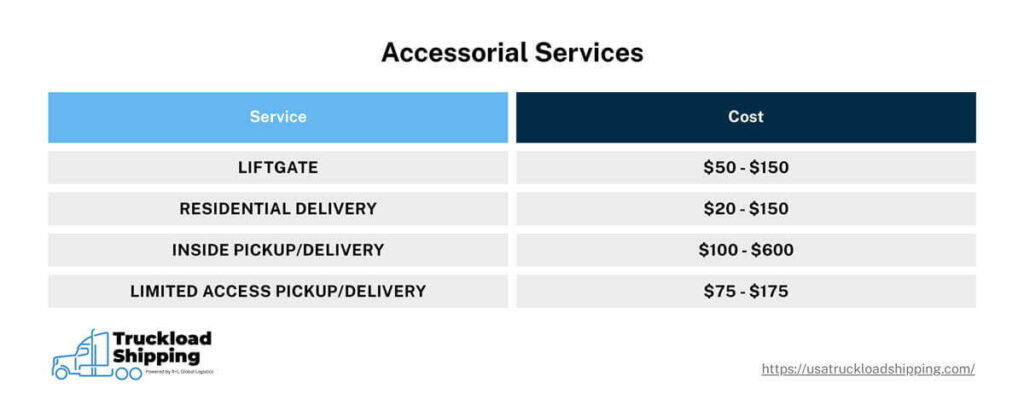
The exact cost is different for every carrier. You can try asking potentially transportation providers how much they’ll charge for prior to booking your load.
USA Truckload has the capacity you need to move large cargo using LTL transport. We use a network of over 22,000 carriers to transport freight all over the country. Our network of reliable carriers allows us to provide a 99.5% on-time delivery rate. When you choose USA Truckload, you’ll also gain access to a variety of transportation services.
If you’re ready to experience the difference a USA Truckload can make, then fill out your RFP today. You can also call our team at (866) 353-7178 if you have more questions, or reach out to us on our contact page.
Most shippers in the United States operate on tight profit margins, which often has business owners looking for ways to decrease their costs as much as possible. If you’re a US-based shipper looking for the best freight rates, you’ve probably run into the terms full truckload (FTL) and less-than-truckload (LTL) during your search. Knowing the differences between these two methods is an important part of building your shipping strategy.
Key Takeaways
In this article, I’ll compare these two forms of truckload shipping, including their advantages, some sample scenarios of when FTL would be preferable to LTL, and vice versa.
For the most part, the difference between FTL and LTL freight is simple:
A misconception new shippers sometimes have is that FTL means the entire trailer will be fully loaded by a single client. This can happen, but it isn’t always the case. By that same token, LTL doesn’t necessarily mean there will be empty space in the trailer.
To make this differentiation easier to understand, let’s examine some advantages of each type of freight shipping.

Some of the most notable advantages of LTL shipping include:
For greater clarity, I’ve put together the following scenarios that show the advantages of LTL shipping at work.
Related: How Do I Find My NMFC Code?
Say you run a relatively small business selling heavy-duty furniture wholesale to retailers. In most cases, your customers prefer to run lean inventories and only order four to eight pallets of goods at a time. These retailers have standing, scheduled orders and rarely require expedited freight shipments.
Here are some reasons LTL would outperform FTL under these circumstances:
When time isn’t of the essence and reduced costs are your number one priority, LTL is a great option for shippers. But what if things were reversed and lower costs aren’t as important as timely, predictable delivery? For that, look to FTL.

You can expect the following benefits when shipping freight via full truckload.
Let’s return to our furniture wholesaler example for a scenario where FTL shipping wins.
In addition to heavy-duty furniture, your wholesale business also offers fragile items such as standing mirrors, glass coffee tables, and chandeliers. One of your customers decides to expand their retail offerings to include such goods, and their initial stocking order will be about 12 to 15 pallets in size. They also want to receive the order within three to four business days to meet projected demands.
FTL will be your go-to option here for the following reasons.
Partnering with a third party logistics (3PL) freight broker can help you choose the best shipping method for your freight on a case-by-case basis.
Related: 3PL vs Freight Broker: Outsourcing Your Logistics Needs
Moving large shipments across the United States requires expertise in logistics and access to a wide variety of delivery vehicles. That’s why shipping businesses of all sizes rely on freight brokerages like us to take the guesswork out of this complex process.
USA Truckload Shipping has access to FTL and LTL carriers across the country, in addition to warehouses and distribution centers. From storage to freight shipping and even final mile delivery, we have the know-how to tackle logistics challenges of all shapes and sizes.
Our full list of services includes:
Call us today at (866) 353-7178 or submit a contact form online. We’re ready to assist you with your entrepreneurial endeavors.
Trying to find freight capacity can be one of the most stressful parts of shipping. If you have goods to ship, but can’t find a carrier, your business will be in a tight spot. Maybe your regular carrier is booked or rates have shot up. Regardless of your unique situation, there are some ways out of this common logistics problem.
Here are six strategies that will help you secure freight capacity:
We’ll explain how these strategies work and the factors that can limit freight capacity.
We’ve already listed the strategies that shippers use to secure capacity for their loads. Now, we’ll show you how each strategy works and how you can implement them when searching for a carrier.
Building strong relationships with carriers is a great way of ensuring you always have capacity. Fortunately, there are multiple ways that you can strengthen the bond between you and your chosen transportation provider.
This includes:
Following these steps is all well and fine, but how do you establish a relationship with a carrier you’ve never worked with before? One way is to complete a request for proposal that’s offered by transportation providers.
When filling one out, you’ll be able to solicit detailed bids, communicate your transportation needs, and specify other requirements. If the carrier is a right fit for your needs, you’ll have begun a new partnership with a strategic partner that can transport your freight.
If an RFP isn’t available, carriers also offer quotes that you’ll fill out prior to shipping.
A 3PL connects you to a broad network of pre-vetted carriers and gives you access to freight services that might otherwise be out of reach. These companies have extensive carrier networks and advanced technology to help their customers.
However, not all 3PLs are reliable. You’ll need to vet your desired 3PL very carefully to ensure the one you select can fulfill your needs.
To do this, look into these aspects of a 3PL:
Some of this information is made available by 3PLs, but you might need to do some research for the others. Nonetheless, these details will give you a good idea of their reliability.
Related: How To Reduce Transit Damage
Relying on just one or two carriers might feel easy, but it comes with risks. If one of them is overbooked or drops a lane, your shipments could be left in limbo.
An easy way to overcome this problem is by working with carriers of various capacities. This will give you more flexibility in your capacity and shipping options. There are many carriers in the U.S. that you can use. To show this, consider some data we’ve provided.

3PLs can help manage your relationship with many of these carriers. Here at USA Truckload Shipping, we work with over 22,000 transportation providers, many of them belonging to the 95.5% that only have a fleet of 10 trucks or fewer. With their support, we’re able to provide a variety of transportation services.
Modern freight tech tools can help you secure capacity faster and with less effort. There are a variety of tools tailored specifically to shippers that you can use to find a carrier.
These include:
Load boards are online platforms that connect shippers with carriers, facilitating the process of securing freight capacity. By posting available loads, you’ll gain access to a broad network of carriers actively seeking freight. This helps you efficiently match shipments with appropriate transportation options.
These platforms use algorithms to connect shippers with carriers that have available capacity, streamlining the process of finding and securing transportation services. By automating load matching, you can quickly identify suitable providers and reduce the time and effort involved in traditional methods.
TMS platforms assist shippers in planning, executing, and optimizing the movement of their goods. They provide functionalities such as carrier selection, freight consolidation, and route optimization. This improves capacity utilization and will increase your cost savings.
When possible, plan your shipments ahead of time. Allowing carriers enough lead time gives them a better shot at planning efficient routes, which often results in lower costs and higher service levels.
Last-minute shipments are sometimes unavoidable, but if your business has seasonal freight or repeat shipments, schedule those loads in advance. Booking early shows carriers that you respect their time and operations. This will also help you strengthen your relationship.
Watching the logistics industry will reveal useful insights about freight capacity. There are a few factors in particular that are worth monitoring.
Each of these factors can determine a surplus or shortage in capacity. By monitoring the market, you’ll be able to anticipate changes and adjust accordingly.
Related: How To Fill Out A Bill of Lading
Now that we’ve talked about what you can do, it’s worth taking a minute to look at what’s outside your control. There are several common factors that limit freight capacity in the U.S. market:
These market forces are tough to control, but the strategies above can help you navigate them with fewer headaches.
At USA Truckload Shipping, we have plenty of capacity to go around. Our vast network of carriers are located across the country, standing ready to provide you with transportation services. They’re all vetted and will handle your freight with care. With their support, we can provide you with a variety of transportation services.
This includes:
Start your relationship with USA Truckload Shipping by filling out your Request for Proposal (RFP). If you have any questions about our services, then call our team at (866) 353-7178 or reach out to us on our contact page.
Two of the most common methods of shipping freight across the United States are intermodal and truckload shipping. While both get your freight where it needs to go, they differ in cost, speed, handling, and flexibility.
Key Takeaways
Understanding the differences between intermodal and truckload shipping can help you avoid delays, reduce costs, and find the right carriers for your freight.
Intermodal freight refers to the movement of cargo using two or more modes of transportation. In the U.S., this often involves a combination of truck and rail. However, intermodal shipping also encompasses air freight and container shipping vessels.
A typical intermodal shipment looks like this: freight is loaded into a container at its origin point, hauled by truck to a rail terminal, transported long-distance by train, then picked up by another truck for final delivery.
Related: How to Ship Freight by Rail: Costs, Benefits, and Key Terms
While truckload and intermodal transportation methods serve the same end goal, they differ in application. From transit time to handling procedures, each mode offers advantages in some situations and challenges in others.
For greater clarity, I’ve compiled some of the most common decision-making factors for choosing between intermodal and strictly truckload freight shipping in the table below.

Each of these categories plays a role in determining which shipping method aligns with your operational priorities. Let’s take a closer look at the two most critical aspects: cost and speed of delivery.
Cost is one of the top concerns for shippers. In many cases, intermodal shipping offers significant savings compared to truckload.
Rail is more fuel-efficient over long distances, and intermodal leverages that benefit to lower transportation costs. However, taking advantage of intermodal’s lower cost requires certain conditions.
When intermodal saves you money:
When truckload is worth the extra cost:
While intermodal can save you a substantial amount of money, it’s important to match the savings opportunity with considerations like delivery times and special handling requirements.
Related: How to Calculate Freight Shipping Costs
Transit time is another vital factor to consider. When comparing the two modes, truckload shipping almost always delivers faster results.
Truckload shipments travel directly from origin to destination, avoiding delays associated with terminal transfers or train schedules. It’s ideal for shippers with time-sensitive freight who can’t afford unexpected stops or slowdowns.
Intermodal shipping, on the other hand, involves multiple steps: truck pickup, rail transit, and truck delivery. While rail is efficient, the coordination between these legs can introduce extra time into the overall delivery schedule.
Choose truckload if:
Choose intermodal if:
The bottom line here is that while truckload almost always wins in speed, intermodal may still be the better choice if your timeline allows for it.
While we’ve discussed the primary differences between these two freight shipping options, examining some hypothetical scenarios will give you an even better idea of when to choose truckload over intermodal and vice versa.
Scenario One
In this case, intermodal is the clear winner for the following reasons:
The combination of long distance travel and a generous delivery time makes intermodal ideal for these consumer goods.
Scenario Two
This shipment would be best served via truckload shipping for reasons such as:
For short range, high-value shipments such as this, FTL will usually be your go-to choice.
Deciding between intermodal and truckload shipping doesn't have to be overwhelming. With the right logistics partner, you can make data-driven choices that lead to efficiency and cost-savings for every load you ship.
At USA Truckload Shipping, we connect shippers with carriers that fit their budget, schedule, and service expectations. Whether you're moving a few loads a month or managing complex national distribution, our team can help.
What we offer:
Call us today at (866) 353-7178 or fill out a request for proposal online. From warehousing to freight shipping and beyond, we’re ready to help your business meet all of its logistics challenges head on.
A smooth freight pickup is the first step to making sure your shipment gets where it needs to go. When everything runs efficiently, your supply chain stays on track, customers stay happy, and your team avoids unnecessary stress. Having a clear, reliable process in place is essential. Let’s take a closer look at how scheduling a freight pickup works.
Key Takeaways:
We’re going to discuss this information in more depth to help you schedule a freight pickup.
Before you reach out to schedule a pickup, it’s important to gather some key pieces of information. Having everything ready upfront helps prevent delays, quote issues, or rescheduling.
Carriers and 3PLs rely on accurate load information to quote shipments, assign the right equipment, and coordinate efficiently. We’ve provided a list of essential information about your freight you’ll need on hand prior to scheduling a pickup.
Make sure you know the:
If you are unsure how to calculate your freight class properly, ensure you are providing all the needed dimensions that would allow the carrier or 3PL to determine it. They will then go on to assign your LTL freight a National Motor Freight Classification code.
If your shipment requires special handling, such as refrigeration, be sure to include that too. Giving your 3PL the full picture helps avoid misquotes or equipment mismatches.
Related: 3PL vs Freight Broker
Accurate pickup and drop-off addresses are essential. This information tells carriers where to go and allows them to more accurately plan out their routes. You’ll also need to provide additional details about each pickup and dropoff location.
This includes:
If the pickup or delivery location doesn’t have a dock, you’ll likely need to add liftgate services to your shipment when you request pickup. Specifying whether locations are business or residential will help carriers navigate these areas.
The same can be said when you determine if there are any access restrictions they’ll need to navigate at each location. Finally, clarifying hours of operations ensures the carrier doesn’t perform pickup or delivery at the wrong time, which can increase your costs. We’ve provided some common pickup windows and cutoff times within the industry.
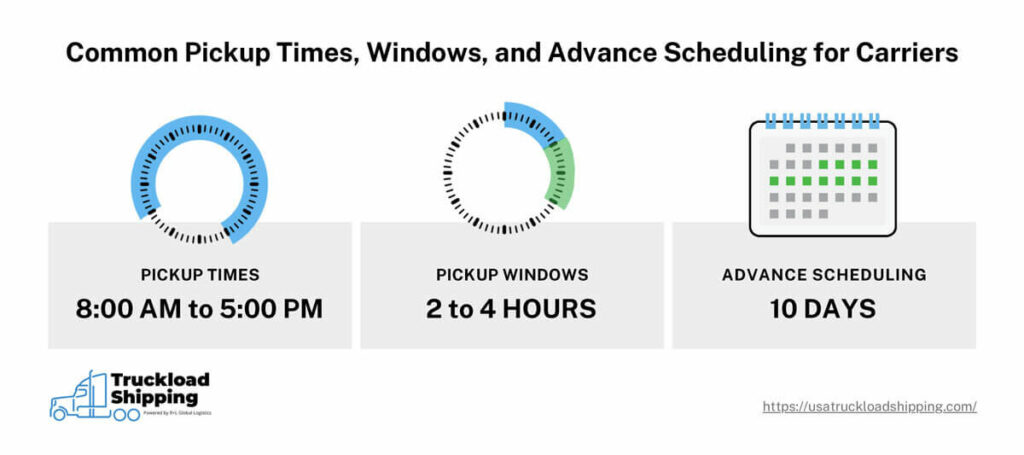
In some cases, carriers may agree to come after typical business hours. However, this will vary based on the transportation provider.
You’ll need to compile contact information for you and the receiver of your freight.
This includes:
When compiling these details, be sure to provide full names, phone numbers, and email addresses. If the driver can’t get in touch with anyone on-site, it could delay your pickup. If possible, find backup contact information as well. This is especially helpful if your warehouse or store has rotating staff.
Now that you have all the information you need, you can start scheduling your freight pickup. Depending on how your 3PL or carrier operates, you’ll be able to set a pickup time using different options.
Many 3PLs and carriers allow shippers to schedule a freight pickup using a Transportation Management System (TMS) or customer portal. In either instance, you’ll have to create an account. From there, you’ll need to enter all the shipment, pickup, and contact information you have available.
Review the details you provide to make sure it’s all correct. If you ship regularly, using a portal can save time and give you better visibility into your freight operations. It also keeps all your orders, documents, and tracking links in one place.
Sometimes, especially for one-off or urgent shipments, you might prefer to just call or email your 3PL contact.
This works well when:
Just make sure your message includes all the details we mentioned above—shipment specs, addresses, and contact info. The more complete your request, the faster a carrier your 3PL can schedule your freight.
When the transportation provider reaches out, they might ask for additional information to finalize the shipment. From there, you’ll need to provide your payment details, which you should never just leave in a voicemail or email message.
Once your freight is scheduled, you’ll receive a pickup confirmation through an email or your customer portal. This will include the estimated pickup window and driver information
Take care of these responsibilities beforehand:
Make sure your freight is packed, secured to a pallet, and labeled
Have your Bill of Lading (BoL) printed and signed
Keep your dock or pickup area clear for the driver
When your carrier arrives, they’ll need to check in and confirm your paperwork. Afterward, the loading process will commence. The company should then provide tracking that you can monitor, either through a link or from your account portal.
Even experienced shippers make small mistakes that can lead to big delays. We’ve listed common mistakes that you should avoid before scheduling a pickup.
Avoiding these mistakes will ensure smooth freight pickup for your freight and prevent unnecessary expenses.
Related: 10 Ways to Reduce Freight Costs
At the end of the day, scheduling a freight pickup doesn’t have to be complicated. With the right 3PL partner and a solid process in place, it can be one of the easiest steps in your workflow. At USA Truckload Shipping, we’re here to make that happen with our quick and reliable services.
If you’re ready to schedule your next freight pickup or want to explore how we can support your logistics needs, fill out a Request for Proposal (RFP) today. For questions or immediate support, give us a call at (866) 353-7178 or visit USA Truckload Shipping’s contact page.
R+L Global Logistics
315 NE 14th St., Ocala, FL 34470